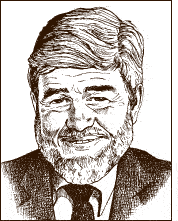

by John Weier July 10, 2001 | |||

In July 1988, during at a lecture at the Woods Hole Oceanographic Institution, oceanographer John Martin stood up and said in his best Dr. Strangelove accent, “Give me a half tanker of iron, and I will give you an ice age.” These inflammatory words centered around a theory known as the iron hypothesis. Martin professed that by sprinkling a relatively small amount of iron into certain areas of the ocean, known as high-nutrient, low-chlorophyll zones (HNLCs), one could create large blooms of those unicellular aquatic plants commonly known as algae. If enough of these HNLC zones were fertilized with iron, he believed the growth in algae could take in so much carbon from the atmosphere that they could reverse the greenhouse effect and cool the Earth. Martin’s theory sparked a tremendous debate. Unlike most of the unusual, somewhat esoteric theories that float about the scientific community at any given time, Martin’s idea had teeth. It could be tested and it had the potential to impact the world on a short time scale. Many of Martin’s contemporaries reacted strongly by claiming his iron hypothesis was ill founded. They felt that his “Geritol” solution to climate change was careless and hazardous for the environment. Corporations and even some countries, however, embraced the idea. They saw Martin’s results as a way to reduce the effects of their own carbon dioxide and bring themselves within the emissions standards set up by the proposed Kyoto Protocol. Meanwhile, the press portrayed Martin as a renegade scientist that came out of nowhere with a mission to prove everyone wrong, calling him “Johnny Ironseed” and “Iron Man.” Martin, a burly, bearded oceanographer with an iconoclastic streak and wry sense of humor, reveled in the controversy and didn’t back down. He stuck to his hypothesis to the end. Several months after his death in 1993, the theory was proven to be correct by his colleagues at the Moss Landing Marine Laboratories. They spread an iron solution into an HNLC zone near the Galapagos Islands and algae bloomed. While the success of this contested experiment established Martin’s legacy, it also overshadowed his earlier work. And there was more to Martin than just this one theory. The iron hypothesis came to him only at the end of a rich life and a prestigious career in oceanography, and it was just one in a long series of discoveries Martin and his colleagues made. In fact, Martin was among the first scientists to successfully test and catalog a wide range of trace metals in the Earth’s oceans. He also demonstrated that copper and zinc could affect measurements of phytoplankton (algae) growth. With regards to the global climate, Martin’s experiments into the amounts of carbon drawn into the seas by algae formed the basis for many of the current large-scale efforts to understand the ocean’s role in the Earth’s carbon budget. Throughout his career, Martin was a scientist with strong instincts, convictions, and ideas that altered forever how scientists regard the Earth’s oceans. next: Personal life |
 On the Shoulders of Giants
Top: A portrait of John Martin. (Drawing by Roger Kammerer) | ||